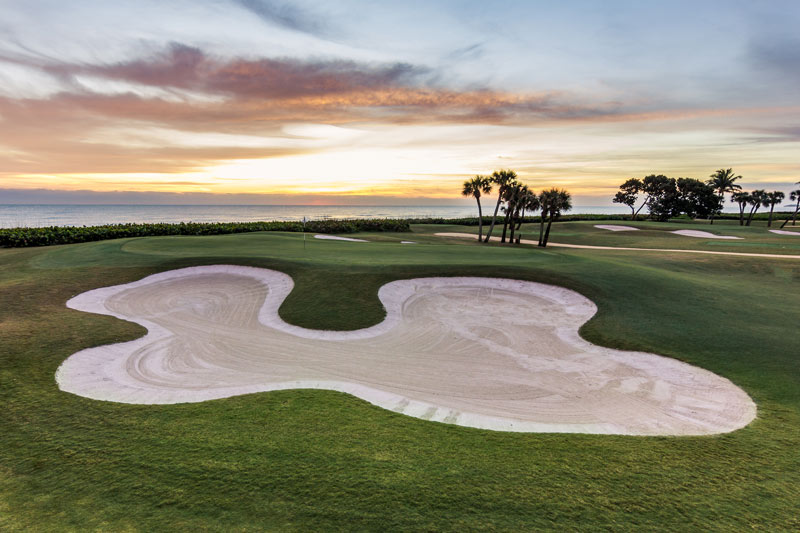
Ocean’s seven: Riomar Country Club’s seven holes on the Atlantic are the most of any golf course in the Sunshine State. An objective of the recent course renovation work was to accentuate the property’s seascapes. Since wrapping up the improvements to Riomar in 2015, superintendent PJ Salter has taken on the role of director of agronomy at Riviera Country Club in Coral Gables, Fla., where he’d previously worked as assistant superintendent from 2006 to 2010. Photos by Jared Blais
When I inquired about the open superintendent position at Riomar Country Club in April 2014, I was unfamiliar with the facility and the city of Vero Beach, Fla., altogether. Upon setting foot on the grounds, though, I quickly realized the quiet beach town was home to one of Florida’s best kept secrets.
In 1919, Herbert Strong elegantly laid out Riomar’s original nine holes over natural rolling sand dunes. Back then, Riomar was the only golf course from Palm Beach to Daytona Beach — about 75 miles in any direction. The club has seven holes on the Atlantic Ocean, and two more and a driving range with views of the Atlantic. Heck, even my office had an ocean view. Riomar is steeped in tradition, made up of members who value understated elegance and friendships within their club.
One of the most exciting aspects about the job opportunity at Riomar was that the club was looking into the possibility of renovating the course, which had gone largely unchanged since its beginnings. Despite boasting those seven holes on the ocean — more than any other course in the state of Florida — continuity, the effects of time, and a few agronomic issues were major drivers to renovate.
The back nine, which had been added on a cleared mangrove swamp in 1962, was so completely different from the front nine that it felt like you were playing two separate golf courses. Adjacent to the Intracoastal Waterway, the back nine sat so close to sea level that half an inch of rain would mean limiting golf on that side to walking-only for about 48 hours. The course’s greens, which had been some of the first planted with TifEagle back in 1998, were push-up style, and soil analysis showed that no two greens’ profiles were the same, which created some management challenges.
Prelude to a transformation
In 2013, as part of the exploratory phase of the project, the club’s board of directors had brought in golf course architect Ron Forse to examine the property and offer suggestions on how the course could be improved. Forse had assembled a plan that included elevating the greens to capture the ocean views, raising the fairways on the back nine to improve drainage, and converting the fairways from a Heinz 57 mix of bermudagrass to Celebration bermudagrass.
Around this time, Jim Callaghan, the club’s storied superintendent of 37 years, announced he would be retiring. With the renovation looming, Riomar set out to find the right blend of experience and ambition to fill the void left by Callaghan and to spearhead the course upgrades. I was fortunate to be selected as Riomar’s next superintendent — a fraternity of fewer than 10 throughout the club’s 98-year history — and in June 2014, I officially joined forces with green committee chairman Dick Haverland and general manager Mark Badertscher, who had already begun searching for an architect and putting together budget expectations for the renovation.
Mark had previously worked with Tom Fazio II, and suggested to the board that he be invited in and interviewed for the position. I had a few close colleagues who had also worked with Fazio, so I picked up the phone to do a bit of research. From those conversations, two points stuck out to me: He’s not your typical architect, and he watches the construction budget and club’s money as if it were coming out of his own pocket. When Fazio arrived for his interview, I realized right away that my friends had been right about one thing: With his shorts, tennis shoes and long hair, he didn’t fit the golf course architect mold. After spending just a little time with Fazio, I could see his energy and passion for the job matched mine, and I knew we would hit it out of the park. He was hired.

The third green at Riomar CC after renovation work. As part of the project, volunteer palm trees were moved from the property line and transplanted to other areas of the course that needed screening, restoring the original ocean views from greens and tees.
We next set out to determine a desired scope of work, a construction timetable, and, with the help of the board, an appropriate budget. All greens would be demolished and rebuilt to USGA specifications. Subsurface drainage would be installed throughout the back nine, and fairways would be raised by an average of 1 foot to solve the drainage problems that would occur following insignificant rainfall events. New ponds would be excavated to increase irrigation storage capacity, reducing reliance on reclaimed water as an irrigation source. Bunkers would be fitted with drainage as well as new sand. Finally, the entire course would be regrassed — greens with TifEagle bermudagrass, and the remainder with Celebration bermudagrass.
In addition to these primary tasks, we compiled a “wish list” of items that would get the green light in the event that we were able to bring the core renovation work in under budget. These included converting areas of rough between fairways to coquina, beefing up landscaping, and addressing a long-standing drainage problem at the cart-staging station. In sum, the wish list consisted of more than $200,000 of extras.
Getting renovation-ready
Collectively, one of the renovation team’s main objectives was to ensure that the new course was delivered on time and on budget. There’s nothing new about that notion, but our unique approach to making it happen was how we gave ourselves the potential to complete those wish list perks.
To do this, Fazio came up with a contract based on unit price. Contractors were given a set of plans detailing areas, volumes and measurements in linear feet, and were then asked to price the project based off that information. Fazio developed the plans by first creating a GPS map of the current golf course and using that data to estimate units of change. Instead of a flat price per green completed, exact linear feet of drainage, volume of drainage rock, volume of greens mix and area sprigged were calculated using a GPS device. These measurements were then entered in a spreadsheet to determine the exact cost of constructing the green based off the contractor’s bid. Using GPS allowed for an extra layer of oversight, and eliminated disputes between the contractor and Riomar over billable work.
In August 2014, Fazio and I began the process of interviewing contractors and collecting bids. I knew that if we could nail down a contractor by the end of month, Riomar would likely be the first job on the books for said contractor, guaranteeing us the sharpest pencil. We had several outstanding contractors bid on the project, and after an extensive vetting process, the club selected John Copeland’s Superior Golf Concepts.
The final matter that needed to be tied up was obtaining the required permits. Given that a large portion of the golf course sits next to the Atlantic Ocean, special permitting from the Florida Department of Environmental Protection (FDEP) would be necessary for any work. This was a major hurdle, and one I wanted to get out in front of, as neglecting this step could prove disastrous to the project’s timetable. What if we decided to spray out a part of the golf course we weren’t permitted to renovate? If a government agency shut us down after the fact, what would we do?
To help navigate these tricky waters, the club enlisted Scott McGuire of Knight, McGuire & Associates, an engineering firm with extensive experience in golf course construction projects. Much of Riomar’s front nine is within what’s known as the Coastal Construction Control Line — established to help preserve beaches and protect against erosion — where any work requires a field permit from the FDEP. The permit would allow the club to work within the zone as long as said work resulted in no net loss of earth from the area.
With all of those ducks in a row, the final preliminary step was to propose the project to the membership, and it would require a majority vote to gain final approval. To pitch the initiative, I prepared a “What to Expect” PowerPoint presentation based on my previous experiences with renovation work. (While superintendent at Dolphin Golf Course at Ocean Reef Club in Key Largo, Fla., from 2010 to 2014, we rebuilt the greens and the bunkers, constructed a new short-game facility, and regrassed fairways, tees and approaches to Celebration bermudagrass.)
Along with the visual aid, Riomar’s treasurer, Ted Michael, explained the financial obligations of the project, Haverland described how the project had evolved to its current point, and Fazio answered questions relative to the proposed scope of the work. Membership gathered to vote in mid-December 2014, and in an unprecedented showing of support, the proposal passed with all but two votes cast in favor.
Digging in
Early 2015 saw the team meet several times to review plan details and make tweaks as needed to ensure the aggressive, seven-month construction schedule would be feasible. On Monday, April 6, construction commenced, and by the beginning of May, Riomar was completely closed and the renovation was in full swing.
The trio of Superior Golf Concepts project manager Kevin Patterson, Fazio and myself quickly established an order of operations. One crew of workers got started on the construction of new USGA greens, and another began the process of stripping and burying the old turf. That process was made more challenging by the fact that the bury pits needed to be found among existing irrigation lines, as the course’s relatively new irrigation system wasn’t being replaced. After old turf was disposed of in the bury pits, drainage was shot into the subsurface, and sand mined from digging the bury pits was transported around the property to raise the grade of the fairways.
This was one of the most remarkable aspects of the project. The back nine required more than 50,000 cubic yards of fill to raise the grade by 12 inches, and all of this fill came from bury pits and pond excavations around the property — none of it was purchased off-site. We estimated this saved more than $500,000. The majority of the fill mined was of beach sand spec, so it drains at a phenomenal rate — much faster than any fill we could have brought in. Now, when it rains at Riomar, the back nine drains faster than the front nine.
Taking all that into consideration, the fact that the back nine went from old turf to new sprigs in just two months’ time was incredible. Granted, we did get some serious help from Mother Nature. Throughout the first 100 days of the project, only 7.5 inches of rain fell, and we lost zero days of work to weather. We finished grassing on July 15 — day 100 — and then, like clockwork, the typical Florida summer rains came. Over the next 100 days, we received just under 30 inches of rainfall, making the grow-in a breeze.

Seaside splendor: Riomar CC is so named because of its location between the Indian River (“rio”) and the Atlantic Ocean (“mar”). The 98-year-old private club was built the same year the city of Vero Beach was incorporated.
A personal goal I’d set for myself with this project was to keep Riomar’s membership — who had shown tremendous support throughout the planning and approval phases — involved every step of the way. While most of Riomar’s members are seasonal, many don’t head north until the beginning of June, so for the first two months of the renovation efforts, I offered a weekly lunchtime tour to interested members, taking them around the course and showing them the different stages of construction and establishment, pointing out challenges and resolutions along the way. Additionally, at the end of each week, I’d send out an email update that included photos of the most recent work.
A plan pays off
It never ceases to amaze me what can be accomplished on a golf course over the course of one summer. In Riomar’s case, the course was torn down, reconstructed and reopened in that span of time. Reflecting on the project, I think three things made it happen so smoothly: planning, support and luck. We had a great team, and we did our homework. Membership voted overwhelmingly to move forward with the project, and gave us all the tools we needed to succeed. And we couldn’t have asked for better weather — dry to move dirt, and then wet to grow in the new grass.
And about that unit-price-based contract: It allowed Riomar to complete all work at a substantial savings to budget, and in turn, the club was able to commission Superior Golf Concepts to complete all of our wish list items. Nov. 1, 2015 saw an opening day that set a new club record for rounds of golf. Consider this gem polished!
PJ Salter is the director of agronomy at Riviera Country Club in Coral Gables, Fla., where he has worked since February 2016. He was the superintendent at Riomar Country Club from 2014 to early 2016. He lives in Miami with his wife, Lisa, and their daughter, Tallulah. Born and raised in Detroit, PJ moved to Florida after graduating from Michigan State University in 2005. He is an 11-year member of GCSAA, and serves on the board of directors of the South Florida chapter.